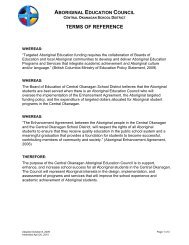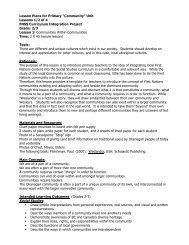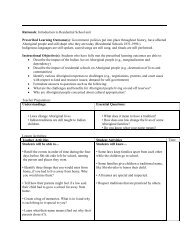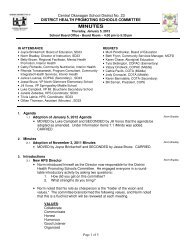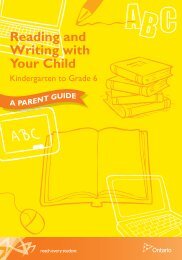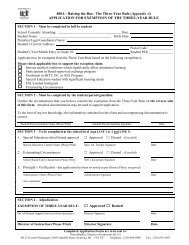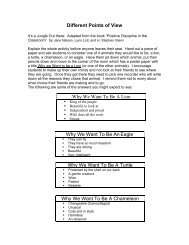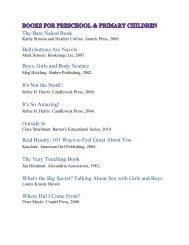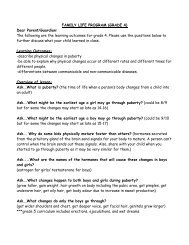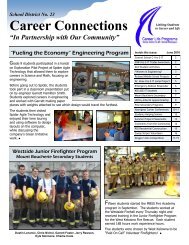Students in My Class.pdf - Central Okanagan School District No. 23
Students in My Class.pdf - Central Okanagan School District No. 23
Students in My Class.pdf - Central Okanagan School District No. 23
Create successful ePaper yourself
Turn your PDF publications into a flip-book with our unique Google optimized e-Paper software.
DEAF AND HARD OF HEARING<br />
Characteristics<br />
Children with hear<strong>in</strong>g loss are often not identified. When a child is<br />
profoundly deaf they are easily identifiable. Most children with<br />
hear<strong>in</strong>g loss are not deaf but have some usable hear<strong>in</strong>g.<br />
Frequently their speech and ability to function <strong>in</strong> the classroom<br />
does not reveal the problems their hear<strong>in</strong>g causes. As you<br />
become more familiar with the student, you may beg<strong>in</strong> to notice<br />
some of the characteristics listed below.<br />
These students may:<br />
• Have headaches / dizz<strong>in</strong>ess or tugs at ear<br />
• Omit / substitute some speech sounds<br />
• Speak too loudly or too softly<br />
• Mispronounce common words<br />
• Request repetition frequently<br />
• Lack confidence<br />
• Frequently watch others before beg<strong>in</strong>n<strong>in</strong>g task<br />
• Make mistakes follow<strong>in</strong>g oral directions<br />
• Give <strong>in</strong>appropriate or irrelevant answers<br />
• Seem to work below potential and show "gaps" <strong>in</strong><br />
learn<strong>in</strong>g<br />
• Seem socially immature, impulsive, disorganized<br />
• Be <strong>in</strong>attentive, impatient, irritable or edgy<br />
• Appear constantly tired<br />
• Have language and vocabulary delays; may not know<br />
common words, idioms, expressions, syntax; may omit<br />
word end<strong>in</strong>gs<br />
• Have difficulty with time concepts and math abstraction<br />
• Lack general <strong>in</strong>formation<br />
• Have auditory memory problems
• Have difficulty with reason<strong>in</strong>g (cause / effect,<br />
judgments, <strong>in</strong>ferences) due to lack of language<br />
experience<br />
• Have difficulty with word attack (sound symbol<br />
associations, phonics)<br />
A Sensori-neural hear<strong>in</strong>g loss is a permanent hear<strong>in</strong>g loss related<br />
to damage to the <strong>in</strong>ner ear.<br />
A Conductive hear<strong>in</strong>g loss is usually temporary but can still have<br />
serious effects on language, speech, learn<strong>in</strong>g, and social skills.<br />
This may be related to ear <strong>in</strong>fections, colds or fluid <strong>in</strong> the ears.<br />
If you th<strong>in</strong>k one of your students has a hear<strong>in</strong>g loss ask the<br />
school based team to refer the child to the hear<strong>in</strong>g resource<br />
teacher.<br />
Instructional Strategies<br />
• Preferential seat<strong>in</strong>g, tak<strong>in</strong>g <strong>in</strong>to account the<br />
configuration of the hear<strong>in</strong>g loss (eg. better ear) and<br />
location <strong>in</strong> the classroom, <strong>in</strong>clud<strong>in</strong>g good visibility of the<br />
speaker's face<br />
• Use of a personal or classroom FM system if<br />
recommended, check<strong>in</strong>g daily for optimum function<strong>in</strong>g<br />
and battery status<br />
• Written back up of oral directions<br />
• Electronic notes or photocopy another student's notes,<br />
or teacher notes<br />
• Allow extra time to write, f<strong>in</strong>ish, or retake tests or labs<br />
• Avoid use of oral tests or audio files whenever possible<br />
• Use close captioned videos whenever possible<br />
• Use visual cues (eg. overheads, graphic website<br />
organizers, pictures, diagrams, outl<strong>in</strong>es, charts)
• Wait time of 4 seconds for process<strong>in</strong>g oral <strong>in</strong>formation<br />
• Ask "wh" questions - avoid "yes / no" questions when<br />
check<strong>in</strong>g for comprehension<br />
Behavioural Strategies<br />
• Pair a student with a buddy to clarify assignments and<br />
<strong>in</strong>formation, <strong>in</strong>clud<strong>in</strong>g PA announcements<br />
• Never turn away or speak from beh<strong>in</strong>d the student<br />
• One speaker at a time and identify ahead of time if<br />
possible<br />
• Provide a daily schedule of class rout<strong>in</strong>e<br />
• Avoid surprises<br />
• Alternate <strong>in</strong>struction time with other activities to give a<br />
rest from "stra<strong>in</strong><strong>in</strong>g" to hear<br />
• Reduce noise level (eg. classroom management, use of<br />
silent overheads, carpet<strong>in</strong>g, cover chair feet - tennis<br />
balls / felt chair slides)<br />
Provide sign language or oral <strong>in</strong>terpreters if needed
VISUAL IMPAIRMENT<br />
Raj is a grade 4 student. He has had a loss of visual acuity over<br />
the summer and cannot see the board, read small pr<strong>in</strong>t, maps or<br />
diagrams. He is very disruptive <strong>in</strong> class, frequently talk<strong>in</strong>g to<br />
other students and <strong>in</strong>terrupt<strong>in</strong>g lessons. Prior to his vision loss,<br />
he was exceed<strong>in</strong>g expectations <strong>in</strong> all subject areas. He had many<br />
friends. Currently, he is struggl<strong>in</strong>g to keep up with his work.<br />
<strong>Students</strong> with low vision have a great deal of difficulty adjust<strong>in</strong>g to<br />
vision loss. All tasks take more time and effort. <strong>Students</strong> fatigue<br />
quickly, get frustrated and anger readily. They cannot easily<br />
locate friends or access <strong>in</strong>formation that is readily available to<br />
their peers.<br />
Needs<br />
• Difficulty see<strong>in</strong>g the blackboard, clock, overhead<br />
projector or any materials that are posted around the<br />
classroom<br />
• When read<strong>in</strong>g most pr<strong>in</strong>t materials may need optical<br />
devices or large pr<strong>in</strong>t<br />
• May have some difficulty with draw<strong>in</strong>g diagrams,<br />
pr<strong>in</strong>t<strong>in</strong>g on worksheets, and work<strong>in</strong>g with maps and<br />
other visual materials<br />
• May need better light<strong>in</strong>g to reduce glare or lower<br />
light<strong>in</strong>g for light sensitivity<br />
• May need additional time to complete tasks <strong>in</strong> the time<br />
allotted<br />
• Will need consideration to adapt the PE programs<br />
• May need visual breaks due to eye stra<strong>in</strong> or visual<br />
fatigue
• May miss non verbal cues which require some peer<br />
<strong>in</strong>tervention strategies<br />
Visual Adaptations<br />
Goal: to provide visual access to materials that the low vision<br />
student cannot easily see.<br />
• Each student's vision is unique; what works for one<br />
person will not necessarily work for another - consult<br />
with your Vision Resource Teacher <strong>in</strong> order to provide<br />
optimum conditions to meet the needs of the student<br />
• Provide preferential seat<strong>in</strong>g for all activities to enable<br />
the student to read near and far materials<br />
• Whiteboards are best; use black or blue markers, green<br />
and red are very difficult to see<br />
• If you do not have a whiteboard, use white chalk on a<br />
very clean chalkboard; yellow chalk on a dusty board is<br />
virtual <strong>in</strong>visible to a student with low vision<br />
• Overhead projectors are hard to see due to glare<br />
• Give students <strong>in</strong>dividual copies of all overhead<br />
materials and those that are posted around the<br />
classroom i.e. schedules, class rules<br />
• Provide optimum light<strong>in</strong>g<br />
• Avoid glare: w<strong>in</strong>dows, lam<strong>in</strong>ated materials, etc.<br />
• Provide adequate desk and shelf space for student<br />
books and equipment; the student will likely require<br />
special equipment and materials such as a slantboard,<br />
computer, magnify<strong>in</strong>g equipment, large pr<strong>in</strong>t books, etc.<br />
The behaviour of students with low vision may lead many people<br />
to underestimate their abilities. They can participate <strong>in</strong> almost all<br />
activities with their peers (with adaptations). Common behaviours<br />
<strong>in</strong>clude: not appear<strong>in</strong>g to make eye contact; speak<strong>in</strong>g out at<br />
<strong>in</strong>appropriate times; miss<strong>in</strong>g social cues (especially body
language and facial expressions); difficulty focus<strong>in</strong>g on lessons,<br />
and seatwork, etc.<br />
Grief and anger surface as students try to cope with new activities<br />
and become more aware of the impact of their visual impairment.<br />
For example, learn<strong>in</strong>g that driv<strong>in</strong>g a car will never be possible can<br />
affect mood, ability to learn, and social <strong>in</strong>teractions.<br />
Instructional Strategies<br />
• Optimum pr<strong>in</strong>t size and font should be determ<strong>in</strong>ed by<br />
you Vision Resource Teacher (VRT), use a clean font<br />
(i.e. Arial) for creat<strong>in</strong>g worksheets, avoid fancy fonts as<br />
they are very hard to read<br />
• High contrast materials are best (black pr<strong>in</strong>t on a white<br />
background)<br />
• Some students are colour bl<strong>in</strong>d - ensure that your<br />
student can see the colours you are us<strong>in</strong>g<br />
• Student and teacher may need to use dark pens or<br />
pencils to write, dark-l<strong>in</strong>ed writ<strong>in</strong>g paper may help<br />
• Avoid poor quality photocopies<br />
• Provide clean, uncluttered diagrams and worksheets,<br />
crowded words and letters are very difficult to read<br />
• Worksheets laid out <strong>in</strong> a l<strong>in</strong>ear fashion are best; avoid<br />
complicated webs<br />
• Leave enough space for the student to write (pr<strong>in</strong>t<strong>in</strong>g is<br />
typically quite large and does not improve significantly<br />
for most low vision students)<br />
• Worksheets may need to be enlarged<br />
• Large pr<strong>in</strong>t textbooks and novels can be ordered<br />
(please give the VRT as much notice as possible)<br />
• Some students do well with magnifiers and some do<br />
not, many require special equipment<br />
• <strong>Students</strong> with low vision typically have difficulty with<br />
organiz<strong>in</strong>g materials, homework etc.
• Allow more time to complete tasks<br />
• Frequent short breaks are required to m<strong>in</strong>imize visual<br />
fatigue and lower <strong>in</strong>stances of "meltdown" due to<br />
frustration<br />
• Reduced quantity of work is acceptable as long as the<br />
student demonstrates mastery of concepts (need to<br />
have the same expectations and consequences as<br />
other students <strong>in</strong> the classroom)<br />
<strong>No</strong>te: The vision of every student is different. Strategies listed<br />
here may not work well with every low vision student. There are<br />
additional strategies - consult your friendly local VRT.
MODERATE INTELLECTUAL DISABILITY<br />
Elementary - Beth is a student with moderate <strong>in</strong>tellectual<br />
disabilities. She is <strong>in</strong> Mr. Harrison's Grade 6 class, but is<br />
function<strong>in</strong>g 5 years below grade level. Shar<strong>in</strong>g with another<br />
student, Beth receives CEA support. Beth participates <strong>in</strong> group<br />
activities with her peers whenever possible. She has b<strong>in</strong>ders of<br />
<strong>in</strong>dependent work at her own ability level which have been<br />
provided by the <strong>Class</strong>room Teacher and Resource Teacher. Beth<br />
counts to 20, but cannot do basic addition and subtraction facts.<br />
She knows the alphabet song but does not know letter sounds.<br />
Beth can identify 1/2 of the alphabet letters <strong>in</strong> isolation. She can<br />
pr<strong>in</strong>t her name and is learn<strong>in</strong>g her home phone number. Beth<br />
receives re<strong>in</strong>forcement for work<strong>in</strong>g hard.<br />
Studies show literacy learn<strong>in</strong>g is a developmental process and<br />
skills will cont<strong>in</strong>ue to be acquired as students are ready for them.<br />
Instructional Considerations<br />
• Ma<strong>in</strong>ta<strong>in</strong> high expectations<br />
• Provide many opportunities for varied experiences and<br />
<strong>in</strong>struction<br />
• Teach functional life skills<br />
• Use concrete language<br />
• Use visual strategies i.e. Picture symbols, PEC (Picture<br />
Exchange Communication), visual schedules, sign<br />
language, gestures<br />
• Teach <strong>in</strong> small manageable chunks, with lots of<br />
repetition<br />
• Differentiate expectations for assignment completion<br />
• Simplify learn<strong>in</strong>g tasks<br />
Behavioural Considerations
• May be easily frustrated when level of work is too<br />
difficult or have difficulty understand<strong>in</strong>g what is be<strong>in</strong>g<br />
asked<br />
• May use behaviour to communicate needs and wants<br />
• May display behaviours typical of much younger<br />
children (i.e. difficulty shar<strong>in</strong>g, temper tantrums)<br />
• May have difficulty understand<strong>in</strong>g social <strong>in</strong>teractions<br />
with peers<br />
• May have a range of <strong>in</strong>terests similar to those of much<br />
younger children<br />
• May respond well to re<strong>in</strong>forcement programs<br />
• May f<strong>in</strong>d transitions difficult<br />
Secondary - Cody is a Grade 12 student with Down Syndrome<br />
Articulation problems make him difficult to understand and he<br />
sometimes uses sign language or pictures to communicate. His<br />
is well liked <strong>in</strong> the school. Cody is work<strong>in</strong>g on an Evergreen<br />
<strong>School</strong> Completion Certificate. His program <strong>in</strong>cludes an IEP with<br />
Transition goals. He works <strong>in</strong> the school cafeteria, and store and<br />
two blocks of community work experience. Cody attends regular<br />
Drama classes, and has 3 blocks <strong>in</strong> the learn<strong>in</strong>g centre. In his<br />
community placements, he has a Certified Education Assistant to<br />
support him but is able to work <strong>in</strong>dependently <strong>in</strong> school work<br />
placements. He has learned to take public transit. <strong>School</strong> staff<br />
are work<strong>in</strong>g with Community Liv<strong>in</strong>g BC on post secondary plans.<br />
Instructional Strategies<br />
• Teach functional life skills<br />
• Curriculum is based on IEP goals<br />
• Development of literacy skills<br />
• Program may <strong>in</strong>clude functional academic skills (i.e.<br />
time, money) that are practiced <strong>in</strong> natural sett<strong>in</strong>gs i.e.<br />
shopp<strong>in</strong>g, tak<strong>in</strong>g transit
• Small group <strong>in</strong>struction for social skills (i.e. Circles<br />
Program)<br />
• Career development and work experience opportunities<br />
• Structured rout<strong>in</strong>e environments<br />
Behavioural Strategies<br />
• Re<strong>in</strong>forcement program (i.e. contracts, token economy)<br />
• Clear and consistent rules<br />
• Opportunity for frequent structured breaks<br />
• Teach relaxation techniques<br />
• Social Stories<br />
• Have peers model appropriate social behaviour<br />
• Provide warn<strong>in</strong>gs prior to transitions
PHYSICAL DISABILITY<br />
Sandeep is a grade seven student enrolled <strong>in</strong> Mr. Sparks class.<br />
She uses a wheelchair <strong>in</strong>dependently. Sandeep has some<br />
weakness <strong>in</strong> her hands so writ<strong>in</strong>g is slow and awkward. She is<br />
work<strong>in</strong>g at the grade seven academic level and is a very capable<br />
writer when she uses voice activated software. Sandeep is a<br />
good friend to many <strong>in</strong> the classroom. Her speech can be difficult<br />
to understand but she is quite articulate once you figure out what<br />
she is say<strong>in</strong>g.<br />
She has a Certified Educational Assistant (CEA) to help her use<br />
the washroom, scribe for her ideas and help her manage her<br />
books and materials.<br />
Characteristics<br />
• Unable to use parts of their bodies<br />
• May tire easily due to muscle fatigue or pa<strong>in</strong><br />
• May have difficulty writ<strong>in</strong>g due to physical challenge<br />
• Often have difficulty participat<strong>in</strong>g <strong>in</strong> PE without<br />
adaptations<br />
• May require additional time to complete academic tasks<br />
• May have difficulty speak<strong>in</strong>g due to impaired oral motor<br />
control<br />
• May require physical assistance (<strong>in</strong>clud<strong>in</strong>g use of<br />
washroom)<br />
• May have difficulty swallow<strong>in</strong>g and/or eat<strong>in</strong>g<br />
• May be on medication to control symptoms or pa<strong>in</strong><br />
• Impaired mobility<br />
• Disability may require that the student take breaks from<br />
the regular classroom rout<strong>in</strong>e<br />
• Disability may be "<strong>in</strong>visible" but may impact attention<br />
and mood
Examples of "Invisible" & "Visible" Physical Disabilities<br />
"Invisible" Physical Disabilities<br />
• Diabetes: mood sw<strong>in</strong>gs because of fluctuations <strong>in</strong><br />
glucose levels<br />
• Epilepsy: lack of concentration or retention because of<br />
small repeated seizures<br />
• Arthritis/Neurofibromyalgia: fatigue and lack of<br />
concentration because of pa<strong>in</strong><br />
• Asthma: fear and/or anxiety because of shortness of<br />
breath<br />
• Bra<strong>in</strong> Injury: compromised memory and/or judgment<br />
"Visible" Physical Disabilities<br />
• Cerebral Palsy/Sp<strong>in</strong>a Bifida: fatigue, physical<br />
discomfort, poor concentration because of physical<br />
position<strong>in</strong>g <strong>in</strong> a wheelchair<br />
• Tourette Syndrome: anxiety, embarrassment and<br />
fatigue because of motor and visual tics<br />
Cal is a grade 10 student who was born with a disability that<br />
caused his arms and legs to rema<strong>in</strong> undeveloped. He walks with<br />
crutches. With much effort Cal has learned to use his feet as<br />
secondary hands and is able to complete most activities<br />
<strong>in</strong>dependently. At school Cal attends classes with his peers; he is<br />
of average <strong>in</strong>tellectual ability. As he cannot write to take notes,<br />
Cal gets his notes from his teacher and tapes his classes to listen<br />
to later. Cal requires a scribe fro written assignments <strong>in</strong> class; for<br />
assignments he uses his voice activated computer. He is fiercely<br />
<strong>in</strong>dependent so he does not like gett<strong>in</strong>g assistance from an<br />
education assistant.
Instructional/Behavioral Considerations<br />
• <strong>Students</strong> may have reduced self esteem due to<br />
physical disability<br />
• Educate peers on the nature of the disability and how<br />
they can assist<br />
• Encourage friendships and allow students time with<br />
their peers without adult <strong>in</strong>teraction<br />
• Ma<strong>in</strong>ta<strong>in</strong> behavioural expectations whenever<br />
appropriate<br />
• Encourage <strong>in</strong>dependence<br />
• Some students are very angry due to their physical<br />
disability and may benefit from counsel<strong>in</strong>g<br />
• Some nonverbal students will use loud vocalization to<br />
communicate<br />
• Some students have periodic visits from Physical<br />
Therapists and Occupational Therapists<br />
• Some physically disabled students require preferential<br />
seat<strong>in</strong>g and require extra space due to equipment
M<strong>in</strong>istry Designations<br />
A<br />
B<br />
C<br />
D<br />
E<br />
F<br />
G<br />
119 Dependent (Level 1 Fund<strong>in</strong>g)<br />
Physically Dependent<br />
Deaf/Bl<strong>in</strong>d<br />
118 Low Incidence (Level 2 Fund<strong>in</strong>g)<br />
Moderate to Profound Intellectual Disability<br />
Physical Disability or Chronic Health Impairment<br />
Visual Impairment<br />
Deaf or Hard of Hear<strong>in</strong>g<br />
Autism Spectrum Disorder<br />
H 116 Intensive Behaviour Intervention/Serious Mental Illness<br />
(Level 3 Fund<strong>in</strong>g)<br />
K<br />
Q<br />
R<br />
P<br />
117 High Incidence (Included <strong>in</strong> the Per Student Allocation)<br />
Mild Intellectual Disability<br />
Learn<strong>in</strong>g Disability<br />
Moderate Behaviour Support/Mental Illness<br />
132 Gifted (Included <strong>in</strong> the Per Student Allocation)<br />
Case Management<br />
Category<br />
Case Managers<br />
____________________________________________________<br />
________________<br />
A Physically Dependent<br />
Resource Teachers
B<br />
C<br />
Deaf/Bl<strong>in</strong>d<br />
Hear<strong>in</strong>g/Vision Teachers<br />
Moderate to Profound Intellectual Disability<br />
Resource Teachers<br />
D Physical Disabilities or Chronic Health Impairment Resource<br />
Teachers<br />
E<br />
F<br />
G<br />
H<br />
Visual Impairment<br />
Vision Teachers<br />
Deaf or Hard of Hear<strong>in</strong>g<br />
Teachers of DHH<br />
Autism Spectrum Disorder<br />
Resource Teachers<br />
Intensive Behaviour Intervention/Serious Mental<br />
Secondary/Elementary<br />
Illness<br />
Counsellors/Behaviour<br />
Specialist<br />
K Mild Intellectual Disability Resource<br />
Teachers<br />
Q<br />
Learn<strong>in</strong>g Disability<br />
Learn<strong>in</strong>g Assistance<br />
Teachers<br />
R<br />
Moderate Behaviour Support/Mental Illness<br />
Secondary/Elementary
Counsellors<br />
P<br />
Gifted<br />
Learn<strong>in</strong>g Assistance<br />
Teachers/<strong>School</strong><br />
assigned staff
HEALTH ISSUES<br />
In your class you may have a student with health issues.<br />
Health Issues:<br />
AIDS (Acquired Immunodeficiency Syndrome) - Is a disease<br />
caused by the human immunodeficiency virus (HIV). the<br />
HIV virus attacks and gradually damages the body's immune<br />
system, its natural ability to fight illness, leav<strong>in</strong>g it open to<br />
serious <strong>in</strong>fections and cancer. AIDS represents the<br />
symptomatic phase seen <strong>in</strong> the later stages of HIV disease.<br />
To develop an appropriate plan, refer to school district policy<br />
for universal precautions.<br />
Cancer - The term cancer refers to a collection of diseases<br />
that have <strong>in</strong> common uncontrolled cell growth and the ability<br />
to <strong>in</strong>vade the body. This ability to <strong>in</strong>vade and destroy the<br />
normal tissue or body organ means that cancer is fatal if left<br />
unchecked. The type of cancer and its severity will<br />
determ<strong>in</strong>e the treatment provided. Primary treatment<br />
options usually consist of a comb<strong>in</strong>ation of medication,<br />
radiation therapy, and surgery. Because of the treatment,<br />
side effects, or complications of the cancer, the child with<br />
cancer may have frequent absences from school and<br />
periodic hospitalizations. In some cases, cancer treatment<br />
may result <strong>in</strong> difficulties with learn<strong>in</strong>g and behaviour.<br />
Diabetes - This results from the failure of the pancreas to<br />
produce the hormone <strong>in</strong>sul<strong>in</strong>. Without <strong>in</strong>sul<strong>in</strong>, the body does<br />
not absorb sugar <strong>in</strong> food, either through a shortage of <strong>in</strong>sul<strong>in</strong><br />
or because the <strong>in</strong>sul<strong>in</strong> produced does not work effectively.<br />
The supply of <strong>in</strong>sul<strong>in</strong> <strong>in</strong> the body may be stimulated by oral
medication or be replaced by <strong>in</strong>jection. Diabetes can not be<br />
cured, but it can be controlled through planned eat<strong>in</strong>g,<br />
<strong>in</strong>sul<strong>in</strong> supplementation, and regular physical activity.<br />
Support: <strong>Students</strong> with Type 1 diabetes on <strong>in</strong>sul<strong>in</strong> pumps<br />
may be supported until they are developmentally ready to<br />
manage their pump. Most <strong>Students</strong> are manag<strong>in</strong>g their<br />
diabetes by Grade 5.<br />
Epilepsy - is a general term for more than 20 different types<br />
of seizure disorders. Epilepsy is not a disease, nor is it a<br />
mental disorder. The number of seizures per day varies<br />
greatly from one <strong>in</strong>dividual to another. Some children may<br />
experience seizures daily while other children may<br />
experience them occasionally. Some childhood seizure<br />
disorders are more difficult to control than others, but<br />
chances are good that prescribed medic<strong>in</strong>e will work well if it<br />
is taken regularly. Seizures may last from 10 seconds to five<br />
m<strong>in</strong>utes.<br />
Support: If a students seizures are well controlled they will<br />
not necessarily be identified as a student with special<br />
needs. In cases where seizures are not well controlled, their<br />
learn<strong>in</strong>g may be impaired.<br />
Severe Allergies - An allergy is an overreaction <strong>in</strong> the body<br />
to a usually harmless substance. The most common<br />
allergies are to pollen, dust, <strong>in</strong>sect bites, moulds, nuts and a<br />
variety of foods. Symptoms such as sneez<strong>in</strong>g, runny nose,<br />
hives, itchy eyes and wheez<strong>in</strong>g may be associated with<br />
allergic reactions. Anaphylactic shock is a severe allergic<br />
reaction. The public health nurse will tra<strong>in</strong> the staff on the<br />
use of any medical procedures necessary. The <strong>in</strong>formation<br />
will be noted on a student's medical alert form. Check the
<strong>District</strong> and school policy and procedures for severe<br />
allergies.<br />
ABC's of Support<br />
Support may be provided by the <strong>School</strong> <strong>District</strong> Nurs<strong>in</strong>g Support<br />
Coord<strong>in</strong>ator. Depend<strong>in</strong>g on student needs, the Nurs<strong>in</strong>g Support<br />
Coord<strong>in</strong>ator will determ<strong>in</strong>e whether or not a Care Plan needs to<br />
be put <strong>in</strong> place.<br />
There are two basic levels of care that the Nurs<strong>in</strong>g Support<br />
Program addresses:<br />
Level 1 Care - Personal care for feed<strong>in</strong>g, dress<strong>in</strong>g, toilet<strong>in</strong>g and<br />
mobility. A CEA may provide this service.<br />
Level II Care - Implementation and supervision of health<br />
procedures necessary while a child is <strong>in</strong> school. Certified<br />
educational assistants are provided student-specific tra<strong>in</strong><strong>in</strong>g on<br />
any procedures required.<br />
Level III Care - Provision of nurs<strong>in</strong>g or rehabilitative services for<br />
those more specialized procedures which require it. Nurses<br />
support any medical needs.<br />
For more <strong>in</strong>formation refer to the follow<strong>in</strong>g Internet<br />
Resources:<br />
Awareness of <strong>Students</strong> with Diverse Learn<strong>in</strong>g Needs,<br />
What the Teacher Needs to Know, Volume 1. M<strong>in</strong>istry of<br />
Education Special Education Resource Guide. Conta<strong>in</strong>s<br />
<strong>in</strong>formation <strong>in</strong>tended to assist classroom teachers <strong>in</strong><br />
understand<strong>in</strong>g the implications for classroom <strong>in</strong>struction and<br />
management of a number of chronic health conditions.<br />
http://www.bced.gov.bc.ca/specialed/awareness/
Awareness of <strong>Students</strong> with Diverse Learn<strong>in</strong>g Needs,<br />
What the Teacher Needs to Know, Volume 2. BC M<strong>in</strong>istry<br />
of Education Special Education Resource Guide.<br />
Companion to Volume 1, this resource conta<strong>in</strong>s <strong>in</strong>formation<br />
<strong>in</strong>tended to assist classroom teachers <strong>in</strong> understand<strong>in</strong>g the<br />
implications for classroom <strong>in</strong>struction and management of a<br />
number of chronic health conditions.<br />
http://www.bced.gov.bc.ca/specialed/awareness/awareness_<br />
v2.<strong>pdf</strong>
INTENSIVE BEHAVIOUR CHALLENGES OR<br />
SERIOUS MENTAL ILLNESS<br />
Support/<strong>in</strong>terventions such as:<br />
• <strong>School</strong>-based counsell<strong>in</strong>g/assessments<br />
• Ongo<strong>in</strong>g, <strong>in</strong>dividual <strong>in</strong>terventions and/or <strong>in</strong>struction <strong>in</strong><br />
social skills<br />
• Behavioural and learn<strong>in</strong>g strategies<br />
• Instructional focus on motivational and behaviour<br />
management skills; i.e. communication, cooperative<br />
and collaborative skills<br />
• Referrals to outside agencies provid<strong>in</strong>g cl<strong>in</strong>ical and<br />
family support around mental health<br />
• Integrated community team plann<strong>in</strong>g<br />
Some students have serious mental health conditions which have<br />
been diagnosed by a qualified mental health cl<strong>in</strong>ician, a registered<br />
psychologist, a psychiatrist or physician. Interventions require<br />
coord<strong>in</strong>ated, cross-agency community plann<strong>in</strong>g such as care<br />
teams (<strong>in</strong>tegrated case management) or 'wrap-around' plann<strong>in</strong>g.<br />
Characteristics<br />
These students:<br />
• Are very vulnerable, fragile students who are seriously<br />
'at risk'<br />
• Have antisocial, extremely disruptive behaviour <strong>in</strong> most<br />
environments (for example, classroom, school, family<br />
and the community)<br />
• Display profound withdrawal or other negative<br />
<strong>in</strong>ternaliz<strong>in</strong>g behaviours
• Display behaviours that significantly <strong>in</strong>terfere with the<br />
student's academic progress and that of other students<br />
• Display these behaviours consistently/persistently over<br />
time
FETAL ALCOHOL SPECTRUM DISORDER<br />
The <strong>in</strong>tellectual abilities of students with FASD can vary greatly -<br />
from severe/profound <strong>in</strong>tellectual disability to gifted. The majority<br />
of students with FASD have average to low average <strong>in</strong>tellectual<br />
ability.<br />
Characteristics<br />
May have difficulties with:<br />
• Generaliz<strong>in</strong>g <strong>in</strong>formation<br />
• Memory<br />
• Sequenc<strong>in</strong>g<br />
• Abstract<strong>in</strong>g<br />
Language development:<br />
• Difficulties with <strong>Central</strong> Auditory Process<strong>in</strong>g<br />
• May have problems with comprehension, discrim<strong>in</strong>ation<br />
and association, sequenc<strong>in</strong>g and memory<br />
Social/emotional function<strong>in</strong>g:<br />
• <strong>Students</strong> with FASD may display a variety of atypical<br />
responses to unfamiliar or frustrat<strong>in</strong>g situations<br />
• Increases anxiety may result <strong>in</strong> withdrawal, outbursts or<br />
other act<strong>in</strong>g out behaviours that may be harmful to the<br />
student or others <strong>in</strong> the group<br />
• They may be over or under sensitive<br />
• A young child with FASD may have severe temper<br />
tantrums and f<strong>in</strong>d it hard to adjust to change
• Many students with FASD are prone to depression,<br />
poor judgment and impulsivity<br />
Physical function<strong>in</strong>g:<br />
• May present with some or many physical/medical<br />
concerns such as heart murmurs/defects, craniofacial<br />
defects, sp<strong>in</strong>a bifida, bra<strong>in</strong> defects, eye problems and<br />
more<br />
There are 4 diagnostic categories which FASD covers:<br />
• Fetal Alcohol Syndrome (FAS)<br />
• Partial Fetal Alcohol Syndrome (PFAS)<br />
• Alcohol Related Neurodevelopmental Disorder (ARND)<br />
• Alcohol Related Birth Defects (ARBD)<br />
Behavioural Considerations<br />
• Memory difficulties<br />
• Slow auditory process<strong>in</strong>g<br />
• Dysmaturity, act 'young' for their age<br />
• Difficulty predict<strong>in</strong>g outcomes<br />
• Impulsivity<br />
• Easily manipulated<br />
• Difficulty mak<strong>in</strong>g friends<br />
• Short attention span<br />
• May be unable to wait their turn<br />
• May not perceive social cues from others<br />
• May become quickly frustrated with school work and<br />
may become easily overwhelmed<br />
Other challenges or conditions commonly observed <strong>in</strong> children<br />
with FASD <strong>in</strong>clude:
• Learn<strong>in</strong>g Disabilities (LD)<br />
• Attention Deficit/Hyperactivity Disorder (AD/HD)<br />
• Anxiety<br />
• Behaviour challenges<br />
• Drug and alcohol problems<br />
• Mental health problems<br />
Behavioural Strategies<br />
• Remember - It is not that the student "won't" do the<br />
assigned task or behaviour, it is that he or she "can't"<br />
do it.<br />
• Change environment<br />
• Provide supervision<br />
• Provide structure<br />
• Model appropriate behaviour<br />
• Teach the use of self talk to help stay focused<br />
• Use a quiet area<br />
• Provide frequent breaks
ATTENTIONAL DIFFICULTIES<br />
Jeff is <strong>in</strong> the grade eight program. He is very active <strong>in</strong> class,<br />
engag<strong>in</strong>g <strong>in</strong> lively discussions with his teachers and peers; he is<br />
liked by all. However, dur<strong>in</strong>g times of direct <strong>in</strong>struction, Jeff is<br />
often distracted and can be found either doodl<strong>in</strong>g on his desk or<br />
try<strong>in</strong>g to engage his peers <strong>in</strong> talk<strong>in</strong>g. He often misses the content<br />
of lessons and can be found try<strong>in</strong>g to figure out the expectations<br />
for assigned work. His teachers compla<strong>in</strong> that his assignments<br />
are usually messy, disorganized, and frequently off topic. Often<br />
Jeff does not hand <strong>in</strong> any assignments. Even Jeff's PE teacher is<br />
frustrated as Jeff cannot seem to rema<strong>in</strong> still long enough to listen<br />
to the rules of games played <strong>in</strong> class. Every time a staff member<br />
speaks to Jeff about his off-task behaviour he says that he is<br />
aware of the concern and will try harder <strong>in</strong> the future.<br />
Instructional Strategies:<br />
Predictability:<br />
• Develop or access prior knowledge<br />
• Preteach, reteach and review (both behaviour and<br />
academic) especially at pre-break times<br />
• Show an example of the f<strong>in</strong>ished project<br />
Organization:<br />
• Provide charts and diagrams to present and represent<br />
<strong>in</strong>formation<br />
• Provide organizational structures such as folders,<br />
colour-coded files, etc.<br />
• Reduce the amount of work<br />
• Provide a study guide for the lesson<br />
• Guided note tak<strong>in</strong>g (direct <strong>in</strong>struction)<br />
• Unclutter the page
Learn<strong>in</strong>g Style/Assessment:<br />
• Allow for variety of ways to represent learn<strong>in</strong>g<br />
• Provide alternatives to writ<strong>in</strong>g<br />
• Assess learn<strong>in</strong>g <strong>in</strong> a variety of ways<br />
• Use pla<strong>in</strong> language
STUDENTS WITH AUTISM SPECTRUM DISORDER<br />
Greg is a Grade 9 student with Autism Spectrum Disorder. He<br />
likes his daily rout<strong>in</strong>es and is resistant to change. He has<br />
difficulty mak<strong>in</strong>g transitions from one subject to another. Although<br />
he is very chatty and sociable with adults, he has difficulty<br />
<strong>in</strong>teract<strong>in</strong>g with his peers and mak<strong>in</strong>g friends. Greg is able to<br />
meet grade level outcomes with adaptations and will graduate<br />
with a Dogwood. Greg has strong computer skills and an <strong>in</strong>terest<br />
<strong>in</strong> mechanical th<strong>in</strong>gs. He requires 1-2 blocks of homework<br />
support.<br />
Tracy is a student with Asperger's Syndrome. She is enrolled <strong>in</strong><br />
Mrs. Black's Grade 4 class. Tracy requires prompt<strong>in</strong>g to start<br />
work. She has very few friends and is awkward with peers.<br />
Academically she has difficulty generat<strong>in</strong>g her own ideas, but<br />
given facts, can complete assignments. When Tracy is<br />
overwhelmed she requires a quiet place to regroup. She really<br />
likes horses and loves to speak at length about them.<br />
<strong>Students</strong> with Autism Spectrum Disorder (ASD) may <strong>in</strong>clude:<br />
Autism, Asperger's Syndrome,Pervasive Developmental<br />
Disorders (PDD), Rett's Syndrome, Childhood Dis<strong>in</strong>tegrative<br />
Disorder.<br />
Characteristics<br />
• Difficulty develop<strong>in</strong>g peer relationships appropriate to<br />
developmental level<br />
• Lack of social or emotional reciprocity<br />
• Lack of spontaneous seek<strong>in</strong>g to share enjoyment,<br />
<strong>in</strong>terest or achievements with others<br />
• Lack of perspective tak<strong>in</strong>g
• Limited or no eye contact<br />
• Restrictive <strong>in</strong>terests<br />
• Sensory dysfunction:<br />
- Oversensitive to loud noises such as gyms,<br />
crowded hallways, and shop classes<br />
- Aversion to touch<br />
- Avoidance of messy th<strong>in</strong>gs<br />
• Rule bound<br />
• May not generalize skills to other areas<br />
• Resists change <strong>in</strong> learn<strong>in</strong>g environment<br />
• Difficulty with unstructured time, wait<strong>in</strong>g and transitions<br />
• Difficulty with abstract concepts<br />
• Anxious around changes <strong>in</strong> rout<strong>in</strong>es and staff<strong>in</strong>g<br />
• Strong visual learner<br />
• May excel at subjects requir<strong>in</strong>g rote memory<br />
• Difficulty with written output<br />
• May demonstrate unusual behaviours (ie: rock<strong>in</strong>g, hand<br />
flapp<strong>in</strong>g, mouth noises, self talk)<br />
• May have difficulty ga<strong>in</strong><strong>in</strong>g and susta<strong>in</strong><strong>in</strong>g attention on<br />
classroom activities<br />
• May demonstrate clumsy, awkward, and/or<br />
uncoord<strong>in</strong>ated movements<br />
• Poor f<strong>in</strong>e motor coord<strong>in</strong>ation<br />
• Experience difficulties dur<strong>in</strong>g unstructured times (ie:<br />
lunch, break and PE times)<br />
Learn<strong>in</strong>g strategies<br />
• Provide a visual schedule (ie: pictures or text)<br />
• Provide help with <strong>in</strong>formation process<strong>in</strong>g<br />
- Visual organizers, semantic mapp<strong>in</strong>g,<br />
highlight<strong>in</strong>g<br />
- Pre-teach concepts<br />
• Provide direct teach<strong>in</strong>g<br />
• Provide longer wait time
• Avoid verbal overload (use pictures paired with short<br />
concise directions)<br />
• Provide clear behavioural expectations<br />
• Prepare the student for all environmental and/or<br />
changes <strong>in</strong> the rout<strong>in</strong>e<br />
• Provide a predictable and safe environment<br />
• Provide "time away - quiet spot" to regroup and f<strong>in</strong>d<br />
solace<br />
• Teach calm down rout<strong>in</strong>e<br />
• Facilitate social <strong>in</strong>teractions with peers<br />
• Dur<strong>in</strong>g lectures allow motor breaks (stand<strong>in</strong>g at back of<br />
class, 5 m<strong>in</strong>ute walk around)<br />
• Identify motivators and implement a cont<strong>in</strong>gency<br />
system<br />
• Pre-mack the schedule: First....Then (less preferred<br />
activity followed by preferred activity)<br />
• M<strong>in</strong>imize classroom noise<br />
• Capitalize on strengths and <strong>in</strong>terests to engage<br />
students <strong>in</strong> the learn<strong>in</strong>g tasks<br />
• Reduce amount of written output<br />
• Use computer to assist with written output (ie: Assistive<br />
technology: Kurzweil 3000 and Clicker 5)<br />
• Use concrete language<br />
• To <strong>in</strong>crease time on task or prepare for transitions use<br />
a "timer or count down strip"<br />
• Break tasks down <strong>in</strong>to smaller steps<br />
• Present tasks <strong>in</strong> several ways (ie: visually, verbally,<br />
physically)<br />
• Identify optimal seat<strong>in</strong>g<br />
Available Resources:<br />
Autism Community Tra<strong>in</strong><strong>in</strong>g: www.actcommunity.net<br />
BCTF Teach<strong>in</strong>g to Diversity:<br />
www.bctf.bc.ca/Teach<strong>in</strong>gtoDiversity
M<strong>in</strong>istry of Education Special Programs Handbook: Teach<strong>in</strong>g<br />
<strong>Students</strong> with Autism - A Resource Guide for <strong>School</strong>:<br />
www.bced.gov.bc.ca/specialed/docs/autism.<strong>pdf</strong><br />
Prov<strong>in</strong>cial Outreach Program for Autism and Related<br />
Disorders: www.autismoutreach.ca
STUDENTS WHO ARE GIFTED<br />
Charlie is a grade 4 student who excels at Math. He is work<strong>in</strong>g<br />
through the grade 6 math curriculum. He is a bit of a dreamer<br />
and presents <strong>in</strong> class as disorganized and not particularly<br />
engaged <strong>in</strong> learn<strong>in</strong>g unless it is a topic he has a lot of <strong>in</strong>terest <strong>in</strong>.<br />
He was very focused on the tsunami relief and is worried about<br />
environmental issues.<br />
Shannon is a grade 9 student who has exceptional ability <strong>in</strong> all<br />
language areas. She has an extensive vocabulary and likes to<br />
talk, often be<strong>in</strong>g very "social" and off task <strong>in</strong> class. Given a<br />
choice she would prefer to spend all of her time read<strong>in</strong>g novels.<br />
She is also a talented writer both <strong>in</strong> poetry and stories. She has<br />
aspirations of be<strong>in</strong>g an author. Shannon is enrolled <strong>in</strong> a regular<br />
grade 9 program. Written work exceeds expectations <strong>in</strong> English<br />
but does not stand out as a gifted student <strong>in</strong> other subjects.<br />
<strong>Students</strong> like Shannon and Charlie may or may not be formally<br />
labeled as Gifted and many Gifted students are actually labeled<br />
as Learn<strong>in</strong>g Disabled because they have exceptional strengths <strong>in</strong><br />
some areas but significant challenges <strong>in</strong> others. For example, it is<br />
not unusual for a gifted student to have written output difficulties.<br />
Characteristics<br />
• <strong>No</strong>t necessarily a 'high achiever'<br />
• Rapid learn<strong>in</strong>g ability, understands concepts easily<br />
• Easily bored and frustrated with tedious repetitive tasks<br />
• Unusual curiosity - wants to know 'why'<br />
• Able to perceive, visualize, and generalize about<br />
patterns, structures and relationships<br />
• Energy and persistence <strong>in</strong> solv<strong>in</strong>g problems
• Vivid imag<strong>in</strong>ation and sense of humour<br />
• Often moral and personal sensitivity - concerned with<br />
fairness or justice<br />
• Often concerned with 'big picture' or global issues<br />
Behavioural Issues<br />
• Study skills and work habits are often not well<br />
developed because th<strong>in</strong>gs have tended to come with<br />
little effort<br />
• Social and emotional skills are often <strong>in</strong>congruent with<br />
<strong>in</strong>tellectual capabilities<br />
• Many gifted students are more comfortable talk<strong>in</strong>g and<br />
work<strong>in</strong>g with adults or older students<br />
• Many gifted students feel isolated and misunderstood<br />
• Undue demands are often placed on them as they are<br />
perceived to be more mature and responsible<br />
• Parents, teachers, and often the students themselves,<br />
set unrealistic goals which end <strong>in</strong> frustration and<br />
feel<strong>in</strong>gs of failure<br />
• Many gifted students are not self-directed, <strong>in</strong>dependent<br />
learners who need little direction<br />
• Many gifted students do not have the patience or desire<br />
to serve <strong>in</strong> a 'helper' or 'teacher' role<br />
Instructional Strategies<br />
• Develop a strong relationship by acknowledg<strong>in</strong>g the<br />
talents, strengths and <strong>in</strong>terests of the student<br />
• Provide opportunities for accelerated learn<strong>in</strong>g<br />
• Compact the learn<strong>in</strong>g by hav<strong>in</strong>g the student only do the<br />
most challeng<strong>in</strong>g problems - just enough to<br />
demonstrate competence. This avoids tedium and<br />
allows time for enrichment activities
• Provide opportunities for shar<strong>in</strong>g learn<strong>in</strong>g,<br />
understand<strong>in</strong>gs or passions with others<br />
• Provide opportunities for work<strong>in</strong>g with other gifted<br />
students<br />
• Plan open-ended assignments that allow for choice and<br />
for exploration of a topic <strong>in</strong> more depth<br />
• Differentiate expectations with class assignments<br />
• Allow time dur<strong>in</strong>g the day to engage <strong>in</strong> personal <strong>in</strong>terest<br />
or passion areas<br />
• Enroll students <strong>in</strong> challenge or stretch programs when<br />
available<br />
• Select elective courses to meet the <strong>in</strong>terests and<br />
strengths of the student<br />
• Set clear and appropriately high expectations for<br />
assignments. Contracts may be useful <strong>in</strong> facilitat<strong>in</strong>g<br />
this<br />
• Monitor and provide support <strong>in</strong> cooperative group work<br />
as they often have difficulty work<strong>in</strong>g collaboratively
STUDENTS WITH LEARNING DISABILITIES<br />
Tyler is a bright, active 12 year old boy <strong>in</strong> grade 7. He readily<br />
shares <strong>in</strong>formation dur<strong>in</strong>g class discussions and seems to have<br />
no difficulty <strong>in</strong> understand<strong>in</strong>g the concepts presented, but has<br />
difficulty <strong>in</strong> read<strong>in</strong>g and complet<strong>in</strong>g written work. <strong>School</strong> supplies<br />
and assignments are often lost. His teachers describe him as<br />
often noncompliant and underachiev<strong>in</strong>g with a history of<br />
<strong>in</strong>complete assignments and refusal to do work. He is easily<br />
distracted and does not follow directions. Teachers do not feel<br />
that his marks reflect his understand<strong>in</strong>g of the material as he does<br />
so poorly on test.<br />
James is a grade 10 student who has been identified as hav<strong>in</strong>g a<br />
severe learn<strong>in</strong>g disability. He is enrolled <strong>in</strong> all regular classes but<br />
receives 2 blocks of support from the Learn<strong>in</strong>g Centre. In class<br />
James seldom appears to be pay<strong>in</strong>g attention to the teachers's<br />
lecture and the notes he does manage to take usually do not<br />
<strong>in</strong>clude the necessary key ideas. His assignments are rarely<br />
completed and often lost before they are handed <strong>in</strong>. His b<strong>in</strong>ders<br />
and locker are a disaster.<br />
<strong>Students</strong> such as James and Tyler may not be labeled as<br />
Moderately or Severely Learn<strong>in</strong>g Disabled (SLD), depend<strong>in</strong>g on<br />
whether formal test<strong>in</strong>g has been completed.<br />
Characteristics<br />
• Learn<strong>in</strong>g Disabilities are neurologically-based and<br />
usually <strong>in</strong>volve a process<strong>in</strong>g dysfunction<br />
• Appears to be a discrepancy between potential <strong>in</strong><br />
different subject areas and demonstrated output<br />
• May be very competent orally but the complexity of<br />
written ideas seen <strong>in</strong> assignments may be very different
• Emotional state changes depend<strong>in</strong>g on success with<br />
various subjects<br />
• May have memory dysfunction<br />
• Vary<strong>in</strong>g degrees of disorganization<br />
• Often passive learners<br />
• May not be able to accurately evaluate their<br />
performance<br />
• Unaware of effective learn<strong>in</strong>g strategies<br />
• May be passive learners<br />
Behavioural Issues<br />
• May use avoidance strategies<br />
• Need a supportive learn<strong>in</strong>g environment where it is safe<br />
to take risks and make mistakes<br />
• Need much reassurance<br />
• Need the teacher to know they are capable, <strong>in</strong>telligent<br />
learners<br />
Teach your students that if they cut their work <strong>in</strong>to manageable<br />
pieces, the whole task will be easier.<br />
Instructional Strategies<br />
• Be explicit about what is to be learned<br />
• Direct <strong>in</strong>struction <strong>in</strong> metacognitive strategies<br />
• Break large tasks <strong>in</strong>to smaller chunks<br />
• Use a few learn<strong>in</strong>g and organization strategies well<br />
rather than many different ones<br />
• Direct <strong>in</strong>struction and monitor<strong>in</strong>g <strong>in</strong> organizational<br />
strategies<br />
• Draw attention to the most important concepts or<br />
directions<br />
• Focus on concept development and avoid<br />
memorization whenever possible
• When memorization is required provide 'cheat sheets'<br />
such as math fact grids, spell checkers, mathematical<br />
or scientific formulas, fact or vocabulary sheets, etc.<br />
• Don't rely on listen<strong>in</strong>g only - provide written or visual<br />
backup<br />
• Incorporate Universal Design for Learn<strong>in</strong>g Pr<strong>in</strong>ciples.<br />
Multiple means of representation (the what of learn<strong>in</strong>g).<br />
Multiple means of engagement (the why of learn<strong>in</strong>g).<br />
Multiple means of expression (how to show learn<strong>in</strong>g)
STUDENTS WITH SEVERE READING DIFFICULTIES<br />
Dylan is a cheerful, engag<strong>in</strong>g student <strong>in</strong> grade 3 who enjoys<br />
participat<strong>in</strong>g <strong>in</strong> all class activities that do not <strong>in</strong>volve read<strong>in</strong>g. He<br />
has valuable ideas to share dur<strong>in</strong>g discussions and grasps<br />
concepts quickly. However, he is only able to read early<br />
emergent material with only one or two sentences on a page. His<br />
writ<strong>in</strong>g is completely phonetic and almost illegible. Read<strong>in</strong>g and<br />
writ<strong>in</strong>g tasks are beg<strong>in</strong>n<strong>in</strong>g to cause obvious stress and<br />
frustration.<br />
Terms often associated with these students are Moderate to<br />
Severe Learn<strong>in</strong>g Disability (SLD) or dyslexic.<br />
Characteristics<br />
• Based on bra<strong>in</strong> dysfunction <strong>in</strong> process<strong>in</strong>g written<br />
language<br />
• Read<strong>in</strong>g disability is usually phonologically based<br />
• Read<strong>in</strong>g is significantly below grade or expected level<br />
• May affect ability to comprehend and/or ability to<br />
decode and spell<br />
• May comprehend more successfully when read<strong>in</strong>g<br />
silently<br />
• Affects read<strong>in</strong>g rate and fluency<br />
• May never develop read<strong>in</strong>g fluency<br />
• Usually will not self monitor for comprehension<br />
• Little or no awareness of effective read<strong>in</strong>g strategies<br />
• Does not vary read<strong>in</strong>g strategies to match the type of<br />
text or purpose for read<strong>in</strong>g<br />
• Often able to meet expected learn<strong>in</strong>g outcomes when<br />
material is read aloud<br />
• May not have developed age-appropriate 'book<br />
language' due to lack of read<strong>in</strong>g experience
• May not have the prior knowledge or concept<br />
development to handle the text<br />
Behavioural Issues<br />
• Self-esteem is an issue due to their learn<strong>in</strong>g disability<br />
and they need a lot of emotional support<br />
• Easily discouraged, feel dumb, easily embarrassed<br />
• May use avoidance strategies<br />
• Need learn<strong>in</strong>g environment where it is safe to take risks<br />
and make mistakes<br />
• Need the teacher to know they are capable, <strong>in</strong>telligent<br />
learners<br />
Curtis is a grade 10 student who is popular with his peers and an<br />
avid athlete and sports fan, knowledgeable about the stand<strong>in</strong>gs<br />
from newspaper reports. However, <strong>in</strong> school he has significant<br />
difficulties with all aspects of read<strong>in</strong>g. His decod<strong>in</strong>g and word<br />
recognition skills are slow and laborious and therefore<br />
comprehension is m<strong>in</strong>imal. He is not able to effectively use the<br />
textbooks <strong>in</strong>dependently <strong>in</strong> any of his content classes, although<br />
he does better with the science text that uses a lot of graphics,<br />
charts and diagrams. Curtis picks up concepts readily when they<br />
are discussed <strong>in</strong> class or <strong>in</strong> small groups. Assignments, when<br />
completed, are done at a m<strong>in</strong>imal level, often miss<strong>in</strong>g key<br />
<strong>in</strong>formation. Dur<strong>in</strong>g work times Curtis is often off task and f<strong>in</strong>ds<br />
frequent reason to leave the room.<br />
Instructional Strategies<br />
• Give extra time for process<strong>in</strong>g when answer<strong>in</strong>g<br />
questions or when read<strong>in</strong>g is required<br />
• Whenever possible provide opportunities for material to<br />
be read aloud to m<strong>in</strong>imize the read<strong>in</strong>g barrier<br />
• Use assistive technology such as Kurzweil
• Provide electronic copies of textbooks (Kurzweil)<br />
• Avoid hav<strong>in</strong>g the student read unfamiliar text aloud<br />
• Access and/or develop prior knowledge to make text<br />
predictable and accessible<br />
• Break read<strong>in</strong>g tasks down <strong>in</strong>to manageable chunks<br />
• Provide a response activity to ensure comprehension<br />
monitor<strong>in</strong>g and reflection<br />
• Limit the amount of writ<strong>in</strong>g required for a response<br />
activity<br />
• Provide a variety of ways of represent<strong>in</strong>g learn<strong>in</strong>g<br />
• Teach po<strong>in</strong>t form notes and s<strong>in</strong>gle word answers<br />
• Use a variety of ways of present<strong>in</strong>g learn<strong>in</strong>g such as<br />
charts and diagrams<br />
• <strong>Students</strong> should know the read<strong>in</strong>g criteria- set purpose<br />
for read<strong>in</strong>g<br />
• Use pla<strong>in</strong> language, specific and concrete directions<br />
• Help them be efficient learners by direct<strong>in</strong>g their<br />
read<strong>in</strong>g or study<strong>in</strong>g time - ie: read the questions first,<br />
provide study guides
MILD INTELLECTUAL DISABILITIES<br />
Hold realistic expectations and provide opportunities to build on<br />
your student's strengths.<br />
Instructional Strategies<br />
• Present assignments and materials <strong>in</strong> smaller<br />
segments<br />
• Allow extra process<strong>in</strong>g/wait/response time.<br />
• Check frequently for understand<strong>in</strong>g.<br />
• Differentiate expectations for assignment completion<br />
• Decrease complexity of assignment<br />
• Tap <strong>in</strong>to prior knowledge<br />
• Pre-teach key vocabulary<br />
• Allow learn<strong>in</strong>g to be demonstrated <strong>in</strong> a way which best<br />
suits her ability and strengths<br />
• Use of the 'th<strong>in</strong>k, pair, share' strategy and other<br />
cooperative strategies address many learn<strong>in</strong>g and<br />
behavioural challenges<br />
• Decrease amount of work<br />
Available Resources:<br />
BCTF Teach<strong>in</strong>g to Diversity Website:<br />
www.bctf.bc.ca/Teach<strong>in</strong>gtoDiversity<br />
M<strong>in</strong>istry of Education Special Programs Handbook:<br />
Teach<strong>in</strong>g <strong>Students</strong> with Intellectual Disabilities -<br />
www.bced.gov.bc.ca/specialed/.....<br />
Behavioural Strategies<br />
• Provide planned breaks i.e. physical movement,<br />
listen<strong>in</strong>g centre, library, computer
• Teach how to use a self monitor<strong>in</strong>g check list for<br />
completion of assignments<br />
• Use social stories and role play<strong>in</strong>g to teach appropriate<br />
social skills<br />
• Provide alternate workspace<br />
• Provide a daily schedule of class rout<strong>in</strong>e and personal<br />
activities us<strong>in</strong>g visual schedules and graphic organizers<br />
• Prepare students for transitions<br />
• Use positive re<strong>in</strong>forcement<br />
• Encourage peer models
STUDENTS WITH WRITTEN OUTPUT DIFFICULTIES<br />
Trevor is a grade 4 student. Accord<strong>in</strong>g to a recent assessment,<br />
he scores <strong>in</strong> the well above average to exceptional range <strong>in</strong><br />
cognitive and academic tests. However he is not pass<strong>in</strong>g many of<br />
his school subjects because he hands <strong>in</strong> very few assignments.<br />
Often those that he does hand <strong>in</strong> lack any <strong>in</strong>dication of<br />
'giftedness'. There are exceptions however, such as a powerpo<strong>in</strong>t<br />
presentation on medieval knights prepared for his social<br />
studies class, which was outstand<strong>in</strong>g. Trevor loves to read and<br />
debate issues at length but his language arts assignments are<br />
simplistic and very brief, if completed at all. With open-ended<br />
topics he has trouble select<strong>in</strong>g a topic, format and 'gett<strong>in</strong>g<br />
started'.<br />
These students are often not diagnosed and can mistakenly be<br />
labeled lazy or as hav<strong>in</strong>g behaviour problems or just need<strong>in</strong>g to<br />
work harder. They may also be labeled as hav<strong>in</strong>g a Severe<br />
Learn<strong>in</strong>g Disability (SLD), a <strong>No</strong>n-Verbal Learn<strong>in</strong>g Disability<br />
(NVLD) or 'dysgraphia'.<br />
Writ<strong>in</strong>g is a very complex neurological process. There are many<br />
factors that affect written output - motor function, language,<br />
memory, mental energy, production control, generat<strong>in</strong>g ideas,<br />
sequenc<strong>in</strong>g to handl<strong>in</strong>g materials.<br />
Characteristics<br />
• May appear 'lazy', unmotivated or defiant<br />
• Often disengaged from school - seem<strong>in</strong>gly unaware of,<br />
or unconcerned with, consequences<br />
• Has not developed the more sophisticated language<br />
and conceptualization required for school success<br />
because of lack of use of written language<br />
• Produce very m<strong>in</strong>imal amounts of written work
• Rarely f<strong>in</strong>ishes or hands <strong>in</strong> assignments<br />
• Frequent careless, repetitive errors<br />
• Writ<strong>in</strong>g shows a serious shortage of facts and ideas<br />
and lacks structure sequence and organization<br />
• Often has a poor active work<strong>in</strong>g memory<br />
• Often has a slow recall of basic math facts and spell<strong>in</strong>g<br />
patterns<br />
• Has difficulty putt<strong>in</strong>g ideas <strong>in</strong>to words when writ<strong>in</strong>g (but<br />
may demonstrate no difficulty when speak<strong>in</strong>g)<br />
• Has difficulty th<strong>in</strong>k<strong>in</strong>g up topics and decid<strong>in</strong>g what to<br />
write<br />
• Has trouble 'gett<strong>in</strong>g started'<br />
• F<strong>in</strong>ds writ<strong>in</strong>g tasks mentally exhaust<strong>in</strong>g<br />
Behavioural Issues<br />
• Poor self-esteem due to their learn<strong>in</strong>g disability and<br />
they need a lot of reassurance and emotional support<br />
• Experience emotional turmoil due to a long history of<br />
be<strong>in</strong>g chastised for poor written work<br />
• Easily discouraged or embarrassed and feel dumb,<br />
especially when others look at their written work<br />
• Have chronic 'writer's block'<br />
• Necessary to understand the function of their many<br />
avoidance tactics<br />
• May appear to be engaged<br />
• Learn<strong>in</strong>g environment where it is safe to take risks and<br />
make mistakes<br />
• Need the teacher to know they are capable, <strong>in</strong>telligent<br />
learners<br />
Kathy is a grade 9 aged student who, for the second year <strong>in</strong> a<br />
row, has failed almost all of the subjects <strong>in</strong> which she was<br />
enrolled. Assignments have been consistently very poorly done<br />
or not handed <strong>in</strong>. Kathy came to this school with an
unremarkable elementary school history, hav<strong>in</strong>g received m<strong>in</strong>imal<br />
marks <strong>in</strong> most of her subjects due to poor attendance and work<br />
habits. Even after attend<strong>in</strong>g summer school follow<strong>in</strong>g grade 8,<br />
she did not pass the courses attempted. Dur<strong>in</strong>g her grade 8 year<br />
she received Learn<strong>in</strong>g Assistance but resisted the support offered<br />
and was not enrolled aga<strong>in</strong> <strong>in</strong> this year. Teachers are reluctant to<br />
give her 'stand<strong>in</strong>g granted' grades until she demonstrates<br />
competency <strong>in</strong> writ<strong>in</strong>g, although standardized academic tests<br />
show her to be scor<strong>in</strong>g at grade level.<br />
Make your classroom a haven for tak<strong>in</strong>g risks.<br />
Instructional Strategies<br />
• Try to determ<strong>in</strong>e the specific area(s) of difficulty and<br />
provide direct support <strong>in</strong> those areas<br />
• Allow student to dictate ideas to a scribe<br />
• Direct <strong>in</strong>struction <strong>in</strong> a variety of writ<strong>in</strong>g genres<br />
• Direct <strong>in</strong>struction <strong>in</strong> a variety of effective spell<strong>in</strong>g<br />
strategies<br />
• Use of graphic organizers or key visuals<br />
• Allow extra time for assignments<br />
• Break large assignments <strong>in</strong>to manageable chunks<br />
• Provide easily accessible lists of vocabulary words for<br />
spell<strong>in</strong>g reference<br />
• Encouragement and direct <strong>in</strong>struction <strong>in</strong> the use of a<br />
spell and grammar checker<br />
• Direct <strong>in</strong>struction <strong>in</strong> keyboard<strong>in</strong>g skills<br />
• Metacognitive development of effective writ<strong>in</strong>g<br />
strategies<br />
• Frequent conferenc<strong>in</strong>g to develop and monitor personal<br />
writ<strong>in</strong>g goals<br />
• Reduce volume of assignments and emphasize<br />
completion rather than amount<br />
• Set specific criteria for assignments
• Encourage and monitor use of time management<br />
strategies such as planners<br />
• Allow student to draw or sketch answers<br />
• Encourage student to draw or sketch ideas before<br />
writ<strong>in</strong>g<br />
• Allow oral answers when possible<br />
• Provide photocopied text and allow the student to<br />
highlight key ideas <strong>in</strong>stead of tak<strong>in</strong>g notes<br />
• Work with a partner to share writ<strong>in</strong>g<br />
• Allow and encourage representation of learn<strong>in</strong>g <strong>in</strong> a<br />
variety of formats<br />
• Provide photocopied notes for study purposes<br />
• Provide study guides<br />
• Use of assignment contracts outl<strong>in</strong><strong>in</strong>g the amount to be<br />
completed
• ADAPTATIONS<br />
•<br />
• Strategies/Supports<br />
•<br />
• Cross-Curricular<br />
•<br />
• Reduce quantity of work (eg. fewer Spell<strong>in</strong>g words,<br />
questions to answer)<br />
• Increase amount of time to complete assignments<br />
• Give choices for assignment format<br />
• Break longer assignments/projects <strong>in</strong>to smaller "chunks"<br />
(highly structured steps, establish due<br />
• Give reasonable extensions to complete project work<br />
• Allow test - tak<strong>in</strong>g adaptations (additional time, enlarged<br />
pr<strong>in</strong>t, scribe, open book, etc.)<br />
• Prepare student ahead of time for what will be asked of him /<br />
her <strong>in</strong> class<br />
• Have student verbalize what he/she does as often as<br />
possible<br />
• Allow wait time to formulate ideas<br />
• Use short, clear, concise directions<br />
• Ask student to repeat directions<br />
• Have student paraphrase directions and demonstrate tasks<br />
before work<strong>in</strong>g <strong>in</strong>dependently<br />
• Accompany teacher directions with demonstrations or visual<br />
examples<br />
• Check comprehension frequently<br />
• Provide study guides, photocopied notes, taped materials<br />
• Provide the opportunity to pre-read materials<br />
• Use "advanced organizers" for watch<strong>in</strong>g video/dvd<br />
presentations<br />
• Highlight/underl<strong>in</strong>e key words or directions on<br />
worksheets/tests
• Use graphic organizers/frames (eg. calendar, visual<br />
schedule, charts, C.O.P.S., etc.)<br />
• Provide written back-up for oral directions<br />
• Allow student to use vocabulary cards, textbook or notes<br />
when writ<strong>in</strong>g a test/quiz<br />
• Use a dictionary, personalized dictionary, word wall & charts<br />
for reference<br />
• Use audio tapes<br />
• Allow access to computer for written assignments (word<br />
prediction, spell-checker)<br />
• Provide complete unit outl<strong>in</strong>e/criteria and a list of key<br />
vocabulary<br />
• Provide parallel, alternate read<strong>in</strong>g materials at student's<br />
read<strong>in</strong>g level<br />
• Allow spell<strong>in</strong>g errors <strong>in</strong> practice assignments or draft writ<strong>in</strong>g<br />
(make limited corrections)<br />
• Emphasize process rather than product<br />
• Use Prescribed Learn<strong>in</strong>g Outcomes from lower grade levels<br />
• Check the student's agenda to ensure it conta<strong>in</strong>s accurate<br />
<strong>in</strong>formation about<br />
• Use a "buddy system" <strong>in</strong> the classroom<br />
• Avoid hav<strong>in</strong>g the student oral read<br />
• Allow student to answer test items orally (or record answers<br />
on a tape recorder)<br />
• Provide proofread<strong>in</strong>g/edit<strong>in</strong>g assistance<br />
• Allow the student to write/rewrite/f<strong>in</strong>ish a test or quiz <strong>in</strong> the<br />
LAT Room<br />
• Provide extra tutorials, reteach<strong>in</strong>g <strong>in</strong> small groups/one-onone<br />
• Provide a tutor/scribe/peer support<br />
• Provide one on one or small group adult support when<br />
available<br />
• Provide Learn<strong>in</strong>g Assistance Teacher support<br />
• Use Kurzweil for assisted read<strong>in</strong>g and writ<strong>in</strong>g
Mathematics<br />
• Provide additional resources for practic<strong>in</strong>g basic facts (eg.<br />
flashcards, game cards, web l<strong>in</strong>ks<br />
• Use SuccessMaker to develop/<strong>in</strong>crease basic Math skills<br />
• Use a calculator<br />
• Avoid timed tests/quizzes<br />
• Use Math manipulatives (eg. counters, ruler, 3-D shapes,<br />
etc.)<br />
• Use Math facts tables<br />
Behaviour Management Strategies<br />
• Use strategic seat<strong>in</strong>g (eg. close to the teacher, close to the<br />
front of the class, away from<br />
• Allow student to stand at times while work<strong>in</strong>g<br />
• Give frequent breaks dur<strong>in</strong>g the day<br />
• Use timer<br />
• Use time-out procedure for misbehaviour<br />
• Use an <strong>in</strong>centive program<br />
• Increase immediacy of rewards or consequences<br />
• Ignore m<strong>in</strong>or <strong>in</strong>appropriate behaviour<br />
• Provide <strong>in</strong>struction <strong>in</strong> self-monitor<strong>in</strong>g strategies (eg. visual<br />
cues)<br />
• Provide immediate specific feedback about behaviour<br />
• Provide pre-<strong>in</strong>struction or review prior to transitions<br />
(expected behaviour)<br />
• Establish clear rout<strong>in</strong>es and discuss them periodically<br />
• Use cues/prompts (private signals)<br />
• Supervise closely dur<strong>in</strong>g transition time<br />
• State behavioural expectations <strong>in</strong> positive terms (what is<br />
expected, rather than what is wrong)<br />
• Implement behaviour management system<br />
• Keep close communication between home and school<br />
(implement a system)
• RESOURCE LINKS<br />
•<br />
• B.C. <strong>School</strong> for the Deaf<br />
• Website: www.bcsdoutreach.bc.ca<br />
• Tel: 604-664-8300<br />
• Fax: 604-664-8308<br />
• TTY: 6L04-664-8304<br />
•<br />
Prov<strong>in</strong>cial Outreach Program for <strong>Students</strong> with<br />
Deafbl<strong>in</strong>dness<br />
• Website: www.sd38.bc.ca/BCDeafbl<strong>in</strong>dOutreach<br />
• Tel: 604-668-7810<br />
• Fax: 604-668-7812<br />
• Email: deafbl<strong>in</strong>d@sd38.bc.ca<br />
•<br />
Prov<strong>in</strong>cial Outreach Program for Autism & Related Disorders,<br />
(POPARD)<br />
• Website: www.autismoutreach.ca/<br />
• Tel: 604-946-3610<br />
• Fax: 604-946-2956<br />
•<br />
Prov<strong>in</strong>cial Integration Support Program, (PISP)<br />
• Website: www.pisp.ca<br />
• Tel: 250-595-2088<br />
• Fax: 250-592-5976<br />
•<br />
Set-BC<br />
• Website: www.setbc.org<br />
• Tel: 604-261-9450<br />
• Fax: 604-261-2256<br />
•<br />
Prov<strong>in</strong>cial Resource Centre for the Visually Impaired (PRCVI)<br />
• Website: www.prcvi.org<br />
• Tel: 604-269-2219
• Fax: 604-261-0778<br />
Cochlear Implants & Auditory Tra<strong>in</strong><strong>in</strong>g Equipment<br />
• Website: http://prp.sd47.bc.ca/<strong>in</strong>dex.htm<br />
• Tel: 604-485-6271 ext 2249 (voice)<br />
• Fax: 604-485-2886<br />
Fetal Alcohol Spectrum Disorder<br />
• Website: www.fasdoutreach.ca/<strong>in</strong>dex.php<br />
• Tel: 250-564-6574<br />
• Fax: 250-563-5487<br />
•<br />
INTERNET RESOURCES:<br />
• Challenges and Opportunities: A Handbook for<br />
Teachers of <strong>Students</strong> with Special Needs with a Focus<br />
on Fetal Alcohol Syndrome (FAS) and Partial Fetal<br />
Alcohol Syndrome (pFAS) Outl<strong>in</strong>es three ma<strong>in</strong> sections:<br />
What is FAS/pFAS?, Identify<strong>in</strong>g Student Needs; and<br />
Access<strong>in</strong>g Services and Strategies. Sample forms,<br />
recommended resources, and student and class profiles are<br />
<strong>in</strong>cluded. Order from BCTF Lesson Aids -<br />
http://www.bctf.ca/LessonAids/<strong>in</strong>dex.html#order<br />
•<br />
• Teach<strong>in</strong>g <strong>Students</strong> with Fetal Alcohol Syndrome BC<br />
M<strong>in</strong>istry of Education Special Education Resource Guide<br />
provides teachers with a clear understand<strong>in</strong>g of the needs of<br />
students with FASD.<br />
http://www.bced.gov.bc.ca/specialed/fas/<br />
•<br />
• American Academy of Child and Adolescent Psychiatry:<br />
Facts for Families provides concise and up-to-date<br />
<strong>in</strong>formation on issues that affect children, teenagers and<br />
their families.<br />
http://www.aacap.org/publications/factsfam/<strong>in</strong>dex.htm
•<br />
• A Sourcebook of Successful <strong>School</strong>-based Strategies<br />
for Fetal Alcohol and Drug-Affected <strong>Students</strong> published<br />
by the Western Regional Center for Drug-Free <strong>School</strong>s and<br />
Communities. Web site: www.nwrac.org/pub/library/s/ -<br />
FAS kids Respond Well to Special Strategies by Bill Hayne<br />
- Preschool Strategies<br />
- K-6 Strategies<br />
- Middle <strong>School</strong> Strategies<br />
•<br />
• The Source for Syndromes by Gail J. Richard and Debra<br />
Reichert Hoge. L<strong>in</strong>guiSystems.<br />
ISBN 0-7606-0242-5 Website: www.l<strong>in</strong>guisystems.com<br />
•<br />
• The Source for Syndromes 2 by Gail J. Richard and Debra<br />
Reichert Hoge. L<strong>in</strong>guiSystems.<br />
ISBN 0-7606-0361-8 Website: www.l<strong>in</strong>guisystems.com



